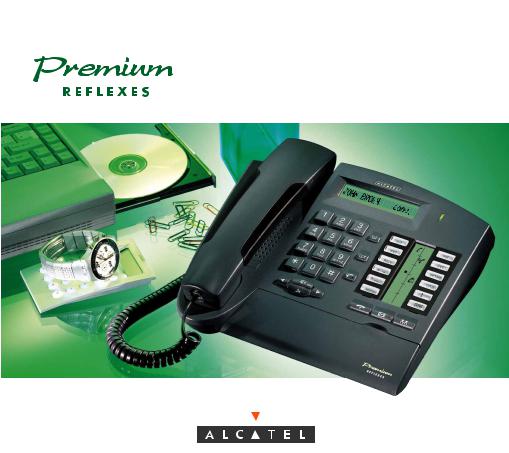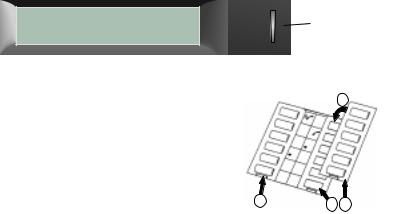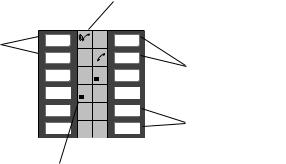Alcatel-lucent PREMIUM REFLEXES, 4020 Manual

Alcatel OmniPCX 4400
User Guide
Premium REFLEXESÔ Alcatel OmniPCXÔ 4400
Your Premium REFLEXESÔ terminal provides simple and quick access to all the services and features offered by your Alcatel OmniPCXÔ 4400 system.
This user guide is designed to give you:
•a full description of your terminal
•an alphabetical index of available services and features
•a step-by step guide explaining how to use these services and features, separated into three sections:
•YOUR CALLS
•EASE OF USE
•IN YOUR ABSENCE
Your REFLEXESÔ terminal and your Alcatel OmniPCXÔ 4400 system provide you with everything you need from a telephone system.
..............................................Name: |
................................Tel. No.: |
Fax No.: ............................................ |
Mobile No.: ................................ |
e-mail address: .................................. |
PWT No.: ................................ |
|
|
1

Symbols used in the documentation
The action "Press" is represented by:
Pre-programmed and user-programmable keys are represented by: 
The standard or site-specific feature codes are listed in the Table of Codes brochure, which should be consulted when the text indicates “Enter the code for...” or “...See Table of Codes.”
FEATURE |
Standard |
Site |
|
Code |
Code |
|
|
|
Last caller call back |
*69 |
|
|
|
|
Programming the keys to customize your terminal is described in “Personalizing your terminal”. You will also find a list of the available programmable features in this section.
2
System information
The availability of some of the features described in this guide depends upon your system configuration. For more information regarding your system configuration, contact your telephone system manager.
Station information
(1)Your terminal permits “on-hook” dialing; this means you can dial calls even before you pick up the handset.
(2)Your terminal can be set up as a multi-line station (two or more line keys) or as a single line station (integrated line service with no line keys). This user guide is designed for multi-line station users. For information on single line service configurations, contact your system vendor.
3
4

Getting to know your REFLEXESTM Premium TERMINAL
i 
5

Display
Your terminal can display several pages of information. If there are multiple pages, the ">" symbol appears on the right side of the display. To move from page to page, use the  and
and  keys.
keys.
When your terminal is idle, the display gives you information on the state of the terminal (e.g., that forwarding has been programmed), or the date and time if nothing has been programmed. During a call, the display gives you information about your party or the current conversation.
The green LED indicates that messages have been received.
Installin
A printed |
4 |
label |
|
•Insert a flat blade into the slot (1 slot for each block of keys).
‚ Raise the cover.
ƒ Slide the printed label into position. „ Replace the cover.
1 |
3 |
2 |
|
6

Station Keys and Icons
Your multi-line terminal has 8 pre-programmed station keys and 4 station keys programmable by you (the user) or your installation technician. These 12 keys are used to:
•determine the status of a terminal,
•call an internal or external number directly,
•access a feature.
Call icons
Line keys |
LINE 1 |
|
LINE 2 |
|
Programmable |
|
|
|
|
|
keys |
STORE # |
CALL LOG |
Pre-programmed |
FORWARD |
CONFERENCEISDN |
|
HOLD |
TRANSFER |
keys |
Feature icons
7

Icons:
Call and feature icons appear next to each key to indicate call or feature status. The following icons are associated with the keys:
Call icons |
Feature icons |
|||||||
Call being made (flashing). |
|
|
|
|
|
|
|
Feature active. |
|
|
|
|
|
|
|
||
|
|
|
|
|
|
|
||
Call in progress. |
|
|
|
|
|
|
|
Feature requiring action. |
|
|
|
|
|
|
|
||
|
|
|
|
|
|
|||
Call on hold. |
|
|
|
|
|
|
|
Terminal or line busy (supervision). |
|
|
|
|
|||||
|
|
|
|
|||||
Call on common hold. |
|
|
|
|
|
|
|
|
Pre-programmed keys are used to:
: access a line, or enter a feature code during a call
: temporarily store a number
: review the list of unanswered identified external calls
: forward calls to another terminal
: talk with two people at the same time (conference call)
: put a call on hold
: transfer a call to another terminal
8

Audio keys
|
Listen - Station speaker (to share |
||
|
|
conversation) or |
|
|
OK (to confirm) certain features |
||
To reduce station |
Listen |
|
To increase station |
|
speaker handset |
||
speaker handset |
|
||
|
|
(receiver), or |
|
(receiver), or |
Speaker |
|
|
|
ringer volume. |
||
ringer volume. |
|
|
|
|
|
|
|
Speaker - for Hands-free operation
Fixed keys - horizontal and vertical Fixed keys correspond to frequently used features.
|
|
|
|
|
|
|
|
Redial: to |
End: to terminate a |
|
|
|
|
|
|
|
automatically |
call or programming. |
END |
|
|
|
|
|
Redial |
redial the last |
|
|
|
|
|
|
|
number dialed |
|
|
|
|
|
|
|
|
||
|
Message: to access |
|||||||
|
|
|||||||
|
|
mail services |
|
|||||
9

Menu: to go into programming mode, to display information on your terminal, or to terminate programming.
Mute: to temporarily turn off your station mic, during your call
or
to leave your mic on (“hot”) to answer internal calls automatically - without having to lift the handset (Interphone).
Alphabetic keypad
Menu
Directory: to access your personal directory
Mute
The keypad is used for the "Dial by name" feature.
10
C O N T E N T S |
|
YOUR CALLS: |
|
Making an external call ................................................................................ |
16 |
Making an internal call ................................................................................. |
16 |
Calling the attendant .................................................................................... |
16 |
Consultation Call ......................................................................................... |
17 |
Calling an associate (or other key individual) ................................................... |
17 |
Answering a call.......................................................................................... |
18 |
Answering calls during a conversation ............................................................ |
18 |
Transferring a call........................................................................................ |
19 |
Putting a call on hold ................................................................................... |
19 |
If you forget or 'lose' a call on hold................................................................ |
20 |
Switching between calls (Broker Calls)............................................................. |
20 |
Picking calls ringing at nother terminals ........................................................... |
20 |
To pick up a call ringing at another terminal (in your call pickup group) ............. |
20 |
To pick up a call ringing at another terminal (not in the pickup group) ................ |
20 |
Calling - using your personal directory............................................................ |
21 |
Calling - using a programmed key ................................................................. |
21 |
Talking with two other people at the same time (Conference Call) ....................... |
21 |
Parking a call.............................................................................................. |
22 |
Requesting a callback (from an idle or busy station).......................................... |
23 |
Camping on to an internal party who is busy .................................................. |
23 |
Answering a night service bell ....................................................................... |
24 |
Entering a scheduled (Meet-me) conference...................................................... |
24 |
Transferring a caller into the conference .......................................................... |
25 |
11
Calling a number - using the system directory .................................................. |
25 |
Barge-in to an internal conversation................................................................ |
25 |
Privacy/Protection against barge-in ................................................................ |
26 |
Calling a party through the station speaker...................................................... |
26 |
Hunt Groups................................................................................................ |
27 |
Temporarily leaving your hunt group .............................................................. |
27 |
Putting a call on common hold....................................................................... |
27 |
Calling an internal party on a pager .............................................................. |
28 |
Dial-By-Name.............................................................................................. |
28 |
EASE OF USE |
|
Personalizing your Premium terminal.......................................................... |
32 |
Programming the free keys or the personal directory for your terminal................. |
32 |
List of the features available .......................................................................... |
33 |
Programming your personal code................................................................... |
34 |
Choosing a display language ........................................................................ |
34 |
Making or taking a call without lifting the handset (Hands-free) .......................... |
34 |
Switching on the station speaker during a call.................................................. |
35 |
Adjusting station speaker volume during a call ................................................. |
35 |
Adjusting handset volume during a call ........................................................... |
36 |
Switching off the microphone (mute) ................................................................ |
36 |
Calling the last number dialed (redial)............................................................. |
36 |
Adjusting the ringer (melody and volume)........................................................ |
36 |
Adjusting the display viewing angle................................................................ |
37 |
Changing the associate number ..................................................................... |
37 |
Identifying the terminal you are on.................................................................. |
38 |
12
Setting an appointment reminder .................................................................... |
38 |
Do not disturb ............................................................................................. |
39 |
Forwarding calls when you are busy.............................................................. |
39 |
Saving a number, to call it later..................................................................... |
40 |
Hiding your identity ...................................................................................... |
40 |
Hiding your caller's identity............................................................................ |
41 |
Allocating calls to customer account codes....................................................... |
41 |
Determining the cost of your last external call................................................... |
41 |
Calling an external "private" number ............................................................. |
41 |
IN YOUR ABSENCE |
|
Forwarding calls to another number (Forwarding - immediate) ........................... |
44 |
Overflowing calls to an associate number........................................................ |
44 |
Forwarding on no answer ............................................................................. |
45 |
Forwarding on busy or no answer ................................................................. |
45 |
Forwarding your calls from a different terminal (Remote Forward) ....................... |
46 |
Forwarding your calls from the terminal you are on (Follow me) ......................... |
46 |
Forwarding calls from any terminal within the company..................................... |
46 |
Forwarding calls to a recorded message (voice mail)........................................ |
47 |
Canceling Forwarding ................................................................................. |
47 |
To cancel forwarding from your own terminal .................................................. |
47 |
To cancel forwarding from the internal terminal that is receiving your forwarding .. |
47 |
To cancel forwarding from any other terminal within the company ...................... |
48 |
Selective forwarding ..................................................................................... |
48 |
Checking messages ...................................................................................... |
49 |
Accessing and Answering callback requests .................................................... |
49 |
13
Reviewing the list of internal calls.................................................................... |
50 |
Checking recorded (voice mail) messages........................................................ |
50 |
Locking your terminal.................................................................................... |
50 |
Forwarding your calls to your personal pager ................................................. |
51 |
Replying when your personal pager sounds..................................................... |
51 |
Calling back the last internal caller whose call went unanswered........................ |
52 |
Consulting the list of external calls .................................................................. |
52 |
GLOSSARY ................................................................................................. |
53 |
INDEX ........................................................................................................ |
57 |
Care of equipment ....................................................................................... |
60 |
Compliance ................................................................................................. |
60 |
14

C A L L S
Y O U R
C A L L S
15

Making an external call
To make an external call:
Dial 9 (or lift the handset and dial 9), then dial the number you wish to reach. The display will show the number you dialed and the icon associated with the line key will indicate the status of your call.
Note: 9 is the default number code for getting an outside line. You can determine the codes for the "Attendant call" and "Direct outside line" features by consulting the Menu key (Guide Mode).
Making an internal call
To make an internal call:
Lift the handset and dial the number you want directly (or use a dialing feature, e.g.: call - using your personal directory). The display will show the name of the person you called, and the icon associated with the line key will indicate the status of your call.
Calling the attendant
To call the attendant:
Lift the handset and dial 0.
Note: 0 is the default number code for the "Attendant call" feature.
16

Consultation call
During a conversation with an internal or external party, you can call a second person. This is sometimes known as a “Consultation call.”
To make a 2nd call:
(1) Select a free line key
(the first party is automatically put on hold (icon 
 ).
).
(2)Dial the number for the second call directly, or call using a dialing feature (e.g.: Call - using your personal directory or the system directory).
(3)You will be connected to the second party.
To cancel the second call and return to the first call:
Press the line key for the first call (on your multi-line terminal).
If you press the wrong button, simply hang up - the telephone will ring and you will be returned to your first call.
Calling an associate (or other key individual)
Each terminal may have another station linked to it as an “associate.”
To call the associate line quickly:
Press the appropriate programmed key or dial the code for the "Associate call" feature.
C A L L S
17
